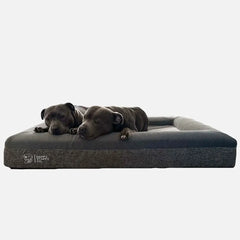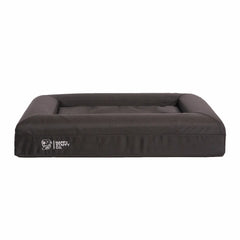
Separation anxiety is one of the most common behavioural challenges for dogs in Australia. It happens when a dog feels distressed or panicked when left alone, often leading to excessive barking, chewing furniture, pacing, or even attempting to escape. While some breeds are more prone to it than others, any dog can develop anxiety if they are deeply bonded with their humans or experience sudden changes to their daily routine.
The right toys can make a world of difference for dogs struggling with this issue. More than just a way to pass the time, well-chosen toys can calm the nervous system, redirect destructive habits into healthy outlets, and create a sense of comfort when you’re not around. They also help your dog associate alone time with positive, rewarding experiences instead of stress. Because every dog’s anxiety triggers, age, and play style are different, choosing the right toy is about matching their individual needs rather than following a one-size-fits-all approach.
Key Takeaways:
-
The right toy can significantly reduce separation anxiety by calming the nervous system, redirecting destructive behaviours, and creating positive associations with alone time.
-
Different toys serve different purposes. Chew toys help release stress, interactive toys provide mental stimulation, and comfort toys offer emotional reassurance, so using a mix is usually most effective.
-
Gradual introduction and positive reinforcement are essential to help your dog form a strong connection with the toy and use it as a source of comfort rather than ignoring it.
-
Toys are most effective when combined with daily exercise, training, calming routines, and, if needed, professional support to address the root causes of anxiety.
-
Personalisation is key because every dog’s anxiety triggers and preferences are unique. Choosing toys that match their play style, chewing strength, and emotional needs leads to better results.
Understanding Separation Anxiety in Dogs

To choose the most effective toys, it’s important to first recognise what separation anxiety is and how it shows up in daily life. Dogs are highly social animals, and when they’re suddenly left without their trusted person, the absence can trigger feelings of stress, confusion, or insecurity. This emotional discomfort often leads to behaviours that owners mistake for disobedience but are actually signs of distress.
Common signs of separation anxiety include:
-
Persistent barking, whining, or howling shortly after you leave
-
Destructive chewing on furniture, doors, or personal items
-
Pacing or circling near exits and windows
-
Accidents indoors despite being toilet-trained
-
Attempts to escape or follow you by scratching doors and walls
The reasons behind this behaviour can vary. Puppies who have never learned independence, rescue dogs with past trauma, or pets facing big lifestyle changes are particularly prone to anxiety. Even small adjustments, such as a new job schedule or moving house, can unsettle a sensitive dog. A lack of physical exercise or mental enrichment also plays a major role, as dogs with excess energy or boredom are more likely to feel anxious when left alone.
Understanding these triggers is the first step to choosing toys that not only entertain but actively address the root causes of their anxiety, providing comfort, mental stimulation, and a sense of safety when you’re not at home.
What to Look for in a Toy for Separation Anxiety

Choosing the right toy for an anxious dog is about more than just entertainment. The best options are carefully designed to ease stress, provide comfort, and keep your dog engaged while you are away. Paying attention to a few essential features will help you find toys that truly make a difference in their emotional wellbeing.
Durability and safety
Dogs experiencing separation anxiety often chew to relieve tension, so the toy must be strong enough to handle repeated use. Look for materials such as natural rubber or reinforced nylon that do not splinter or break easily. Safe construction reduces the risk of choking or injury and ensures the toy lasts longer.
Mental stimulation
A busy mind is less likely to become anxious. Toys that involve problem-solving, like puzzle feeders or treat-dispensing balls, encourage focus and engagement. They transform alone time into a rewarding challenge and help redirect nervous energy into healthy behaviour.
Comfort factor
Soft, comforting toys can make anxious dogs feel less lonely. Plush toys or those infused with a familiar scent mimic the presence of a companion and offer emotional reassurance. They are especially beneficial for puppies or dogs that become distressed when their owners are not nearby.
Self-soothing features
Toys with built-in calming elements can help dogs relax more quickly. Options that include heartbeat simulators, warming inserts, or textured surfaces can reduce stress and create a sense of safety, supporting a smoother transition to being alone.
Ease of use
The best toys work without your involvement. Choose designs your dog can enjoy on their own, whether you are gone for minutes or hours. Independent play builds confidence and teaches your dog to self-soothe without constant reassurance.
Best Toys for Dogs with Separation Anxiety

The right toys can make time spent alone much less stressful and far more enjoyable for your dog. The best options combine strength, engagement, and comfort, offering both physical and mental support when you’re not at home. Here are some top picks based on their purpose and effectiveness.
1. Power Chew Phone
This heavy-duty toy is perfect for dogs who chew as a way to manage anxiety. Its solid, textured design provides hours of satisfying chewing while promoting healthy teeth and gums. The repetitive action of chewing also helps release calming endorphins, which can reduce stress levels and prevent destructive behaviour.
2. Chewzilla Musical Bone
This toy takes chewing to the next level by combining strength with sensory stimulation. The playful sound adds variety to the experience and keeps your dog engaged longer, helping to reduce feelings of loneliness. Its ultra-durable construction makes it suitable for daily use, even with strong chewers.
3. Power Chew Wheel
Ideal for powerful jaws, the Power Chew Wheel provides a safe and long-lasting outlet for stress relief. Its tough, circular design promotes continuous chewing and encourages active play, helping to distract dogs from boredom or anxious habits.
4. Staffy Balboa
Built for durability and fun, the Staffy Balboa is great for dogs that need to release pent-up energy. Its flexible yet resilient texture offers both chewing satisfaction and interactive play potential, supporting emotional balance when your dog is left alone.
5. Staffy Schwarzenegger
For dogs that need a serious outlet for anxiety, this powerful toy offers deep chewing satisfaction and mental comfort. The firm build supports stress relief by encouraging natural chewing behaviour, while the weight and shape provide physical engagement that helps burn off nervous energy.
How to Introduce a New Toy to an Anxious Dog

Introducing a new toy to a dog with separation anxiety requires patience and a thoughtful approach. Even the best toys will not work if they are introduced too quickly or without building trust first. A gentle, positive introduction helps your dog form a strong emotional connection with the toy and encourages them to use it as a source of comfort when you are not at home.
Use positive reinforcement and gradual exposure
Start by placing the new toy in a familiar, safe space without pressuring your dog to interact with it. Allow them to approach it at their own pace, and reward any signs of curiosity such as sniffing, licking, or touching. Once they show interest, encourage short play sessions and praise them for engaging. Gradual exposure builds confidence and helps your dog associate the toy with positive experiences.
Pair the toy with calming routines
Introducing the toy during moments of calm can make it more effective. Offer it after a walk, during quiet time, or when playing soft background music. You can also add familiar scents, such as rubbing the toy with a blanket they use, to make it feel comforting. Pairing the toy with consistent pre-departure cues, like a phrase you always say before leaving, helps your dog understand that alone time is predictable and safe.
Watch for signs of success or resistance
Observe your dog’s behaviour closely in the days following the introduction. Signs the toy is helping include calm chewing or licking, reduced pacing, and a more relaxed posture when alone. If your dog ignores the toy, avoids it, or seems more stressed, it may not be the right match for their personality. In that case, try a different texture, type, or level of challenge until you find the one that truly helps them feel secure.
Extra Support Beyond Toys
Toys are an important part of helping dogs manage separation anxiety, but they are most effective when combined with a broader approach that supports both their physical and emotional needs. Daily routines, calming tools, and professional guidance can all play a vital role in creating a sense of security and building confidence over time.
Daily exercise, training, and desensitisation
A tired, well-stimulated dog is less likely to feel anxious when left alone. Consistent routines help reduce stress and build resilience.
-
Provide regular physical exercise through daily walks, play sessions, or off-lead time in safe areas.
-
Include short training sessions focused on calm behaviours such as “stay” and “settle” to build self-control.
-
Practise desensitisation by leaving the house for brief periods and gradually increasing the duration, helping your dog learn that your departure is normal and temporary.
Calming aids for additional support
Certain products and tools can further reduce anxiety and create a soothing environment.
-
Orthopedic dog beds offer superior joint support and comfort, helping anxious dogs settle more easily and rest without physical discomfort.
-
Raised dog beds improve airflow and provide a secure, elevated spot that can make dogs feel safer and more relaxed, especially in warmer climates or busy households.
When to seek professional help
Some dogs require more structured support than toys and home strategies can provide.
-
A certified trainer or animal behaviourist can identify specific triggers and create a tailored behaviour modification plan.
-
A veterinarian can rule out underlying health conditions or recommend treatments, including medication if needed.
Combining these approaches with the right toys helps create a complete support system. Over time, this reduces anxiety, builds confidence, and allows your dog to feel calmer, more secure, and more comfortable when left on their own.
FAQs
What toy helps dogs with separation anxiety the most?
The best toy depends on your dog’s individual needs, but many anxious dogs respond well to long-lasting chew toys and treat-dispensing puzzles. Chew toys provide a calming outlet for stress and help release feel-good endorphins, while interactive toys keep the mind engaged and distracted from anxious thoughts. For dogs that crave comfort, plush toys with soothing textures or heartbeat features can offer a sense of security.
Can toys alone stop separation anxiety?
Toys are an important part of managing separation anxiety, but they are not a complete solution on their own. Most dogs need a combination of strategies, including exercise, training, calming routines, and gradual desensitisation. Together, these approaches help address the root causes of anxiety while toys provide ongoing support and comfort.
How many toys should I leave when my dog is home alone?
It’s usually best to offer a variety of toys to cover different needs. A good mix might include one chew toy for stress relief, one puzzle or treat dispenser for mental engagement, and one comfort toy for emotional support. Rotating toys every few days can also help maintain your dog’s interest and prevent boredom.



